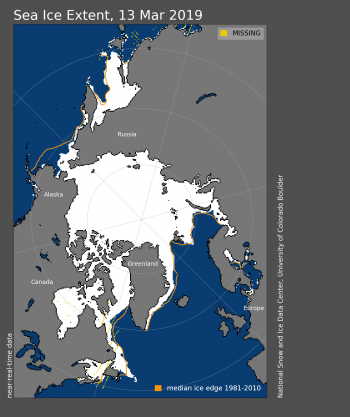Arctic sea ice appears to have reached its annual maximum extent on March 13, tying with 2007 for seventh lowest in the 40-year satellite record. The 2019 maximum sea ice extent is the highest since 2014. NSIDC will post a detailed analysis of the 2018 to 2019 winter sea ice conditions in our regular monthly post in early April.
Overview of conditions

Figure 1. Arctic sea ice extent for March 13, 2019 was 14.78 million square kilometers (5.71 million square miles). The orange line shows the 1981 to 2010 average extent for that day. Sea Ice Index data. About the data
Credit: National Snow and Ice Data Center
High-resolution image
On March 13, 2019, Arctic sea ice likely reached its maximum extent for the year, at 14.78 million square kilometers (5.71 million square miles), the seventh lowest in the 40-year satellite record, tying with 2007. This year’s maximum extent is 860,000 square kilometers (332,000 square miles) below the 1981 to 2010 average maximum of 15.64 million square kilometers (6.04 million square miles) and 370,000 square kilometers (143,000 square miles) above the lowest maximum of 14.41 million square kilometers (5.56 million square miles) set on March 7, 2017. Prior to 2019, the four lowest maximum extents occurred from 2015 to 2018.
The date of the maximum this year, March 13, was very close to the 1981 to 2010 median date of March 12.
Table 1. Ten lowest maximum Arctic sea ice extents (satellite record, 1979 to present)
| Rank | Year | In millions of square kilometers | In millions of square miles | Date |
| 1 | 2017 | 14.41 | 5.56 | March 7 |
| 2 | 2018 | 14.48 | 5.59 | March 17 |
| 3 | 2016 2015 |
14.51 14.52 |
5.60 5.61 |
March 23 February 25 |
| 5 | 2011 2006 |
14.67 14.68 |
5.66 5.67 |
March 9 March 12 |
| 7 | 2007 2019 |
14.77 14.78 |
5.70 5.71 |
March 12 March 13 |
| 9 | 2005 2014 |
14.95 14.96 |
5.77 5.78 |
March 12 March 21 |
A recent paper (Meier and Stewart, 2019) describes the level of accuracy in NSIDC ice extent estimates, with the aim of improving annual minimum and maximum ranking of extents and to determine which years are close enough to be considered tied. For the Arctic maximum, which typically occurs in March, the uncertainty range is ~34,000 square kilometers (13,000 square miles), meaning that extents within this range must be considered effectively equal. The 2019 maximum extent is only 10,000 square kilometers (3,900 square miles) higher than the 2007 maximum, which is within this uncertainty range. Thus, we designate the 2007 and 2019 maximum extents as equal. As is shown in Table 1, other years have also been ascribed tied rankings. NSIDC scientists will rank future maximums and minimums using these criteria.
Final analysis pending
Please note this is a preliminary announcement of the sea ice maximum. At the beginning of April, NSIDC scientists will release a full analysis of winter conditions in the Arctic, along with monthly data for March.
Further reading
Meier, W. N., and J. S. Stewart. 2019. Assessing uncertainties in sea ice extent climate indicators. Environmental Research Letters, 14, 035005. doi:10.1088/1748-9326/aaf52c.

